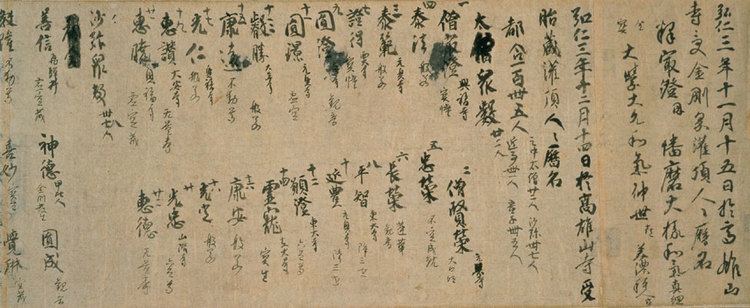 | ||
Abhisheka or Abhishekam (Devanagari: अभिषेक abhiṣeka) is a Sanskrit term akin to puja, yagya and arati that denotes: a devotional activity; an enacted prayer, rite of passage and/or religious rite. Within this range of senses, abhiṣeka is common to all Dharmic faiths such as Hinduism, Buddhism and Jainism.
Contents
Hinduism
Abhisheka, also called Abhishekam, is conducted by priests, by pouring libations on the image of the deity being worshipped, amidst the chanting of mantras. Usually, offerings such as milk, yogurt, ghee, honey, Panchaamrutam, sesame oil, rosewater, sandalwood paste may be poured among other offerings depending on the type of abhishekam being performed. This rite is routinely performed in some Hindu and Jain temples. "Rudraabhisheka" (रुद्राभिषेक) (Abhisheka of Rudra) is performed on Shiva lingams.
Indo-Tibetan Buddhism
In the Indo-Tibetan Buddhist tradition, an abhisheka can be a method for performing esoteric transmission, a way to offer blessings of a lineage to participants, or it can be an empowerment to begin a particular meditation practice.
It originally was used as a consecration rite. Water from the four oceans was poured out of golden jars onto the head of the royalty. It was used during the monarch's accession ceremony and also his investiture ceremony.
Tantric Buddhism
The abhiseka rite is a prelude for initiation into mystical teaching. There are four classes of abhiseaka, each being associated with one of the four Tantras. They are master consecration, secret consecration, knowledge of prajna, and the fourth consecration.
Shingon Buddhism
The Abhiseka Ritual (灌頂, kanjō) in Shingon Buddhism is the initiation rite used to confirm that a student of esoteric Buddhism has now graduated to a higher level of practice. The kanji used literally mean "pouring from the peak", which poetically describes the process of passing on the master's teachings to the student. The rite was popular in China during the Tang Dynasty, and Kukai, founder of Shingon, studied there extensively before introducing this rite to the Japanese Buddhist establishment of the time. A separate initiation rite exists for the general public called the kechien kanjō (結縁灌頂), and symbolizes their initiation into esoteric Buddhism. This rite is generally only offered at Mt. Koya in Wakayama Prefecture in Japan, but it can be offered under qualified masters and under proper auspices outside Japan, albeit very rarely.
The Shingon rite utilizes one of the two Mandala of the Two Realms, depending on the occasion. In esoteric ritual, after the student receives the Samaya precepts, the teacher of the esoteric Buddhism assumes the role of the teacher, usually Mahavairocana Buddha, while the master and student repeat specific mantras in a form of dialogue taken from esoteric Buddhist sutras. The student, who is blindfolded, then throws a flower upon the Mandala that is constructed, and where it lands (i.e. which deity) helps dictate where the student should focus his devotion on the esoteric path. From there, the student's blindfold is removed and a vajra is placed in hand.
